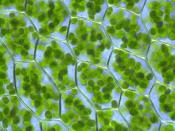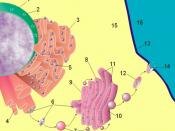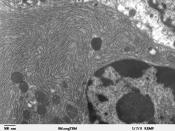Cells are the structure and function of all the animals' and plants' bodies. But animals and plants' cells are different, their structures are not all the same, some of them are and some of them aren't. All living things are made up with one or more cells. Every organelle looks different from others and they all have their own functions.
Plant cells have different size and shapes but they all have the same parts. Plant cells and animal cells are different, plant cells have different structures that the animal cells don't. Plant cells have nucleus, chromosomes, cell membrane, cell wall, cytoplasm, endoplasmic reticulum, chloroplasts, vacuole, and mitochondria. Some of plant cell structures are similar with animal cell. Plant cells and animal cells both have something in common, they have nucleus, chromosomes, cell membrane, cytoplasm, endoplasmic reticulum, vacuoles, and mitochondria. But they also had some difference; plant cells have cell wall and chloroplasts but animal cells don't.
Plant cells and animal cells are not all different and not all the same.
Most cells have nucleus. Nucleus is the organelle that controls plant and animals' cell's activities and the production of new cells. The nucleus is very prominent when you look at it with a microscope. Also you will see some mitochondria, it release energy from the foods you eat, it exist both in the animal cells and the plants cells. In animal and plant cells, there are two kinds of endoplasmic reticulum, smooth endoplasmic reticulum and rough endoplasmic reticulum. The endoplasmic reticulum membrane is a continuation of the outer nuclear membrane. All the cells have a cell membrane, the cell membrane is a covering that holds the animal cells together and separates it from its surroundings.
During the cell life cycle, at the first stage (prophase), the centrosomes begin to push...



Hmmm...
This is just not about the cell. It is also stating the process of cell division.
some differences have been mentioned like animals cells don't contain chloroplasts, but seldom an explaination has been given, in this case it should have said "since they don't carry out photosynthesis."
In a nut shell ,this essay is quite OK , as simple language has been used throughout it.
4 out of 4 people found this comment useful.